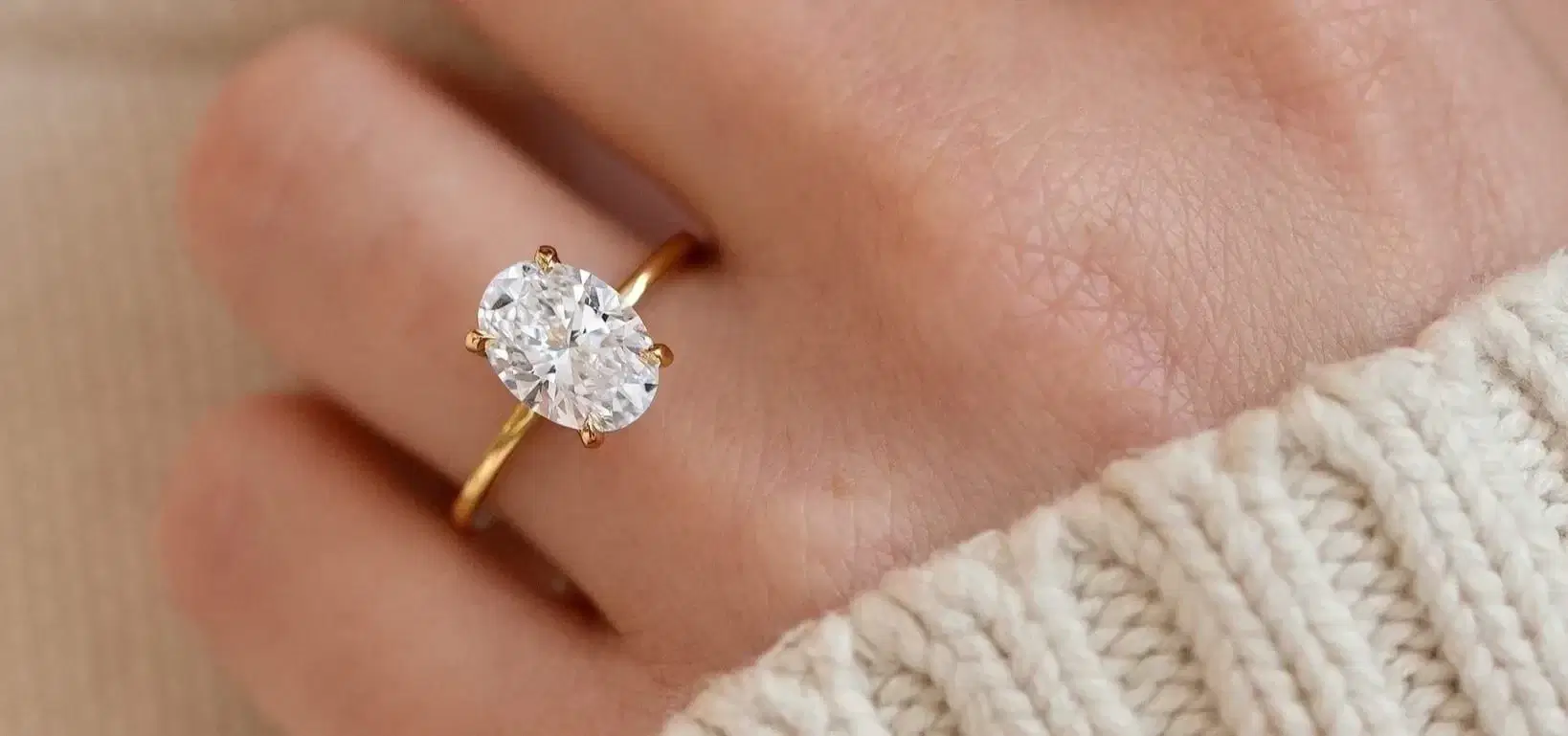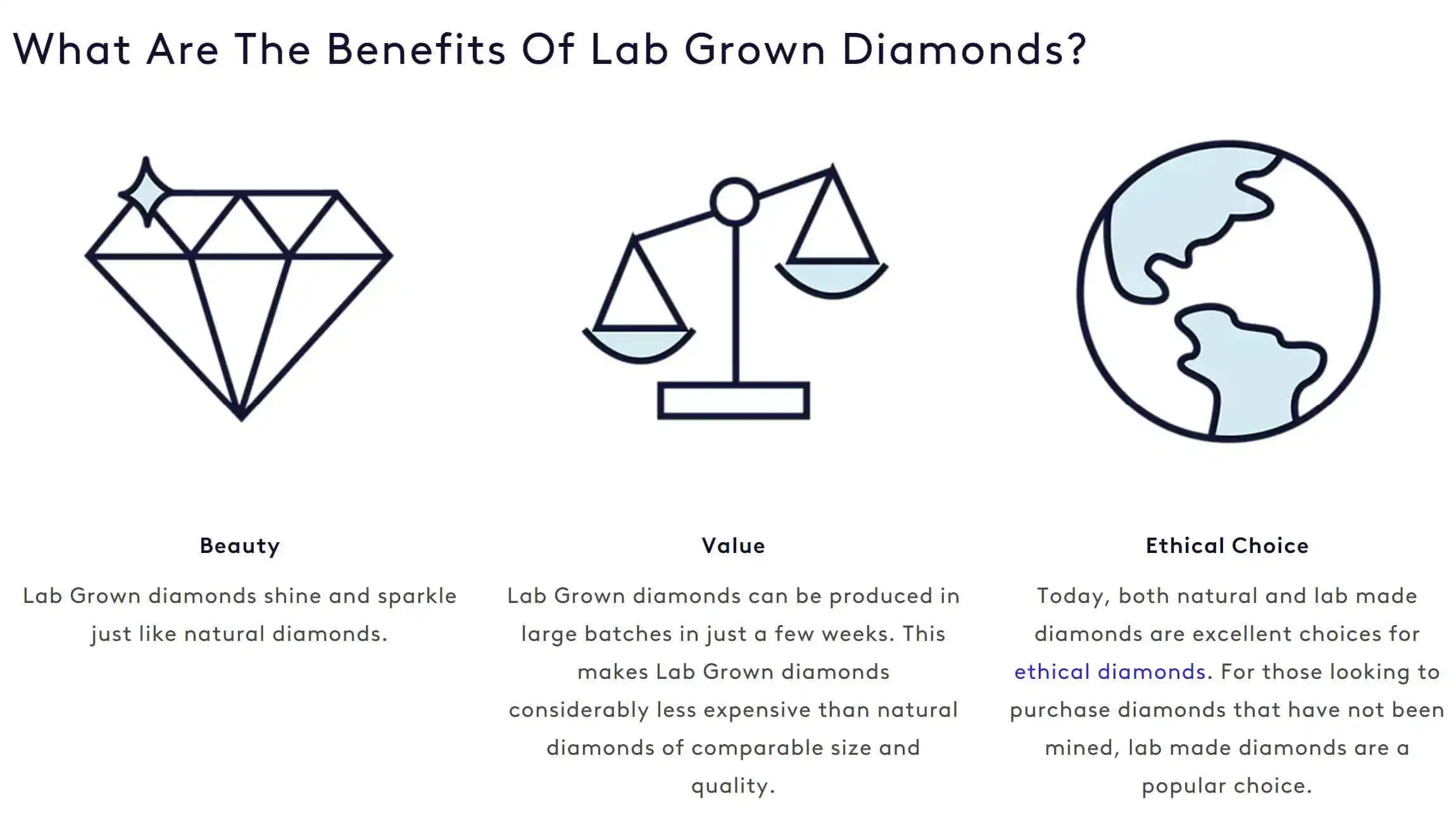Buying a lab-grown
diamond online is the best option, especially if a buyer has gained sufficient insights into acquiring these
diamonds at a reasonable price. Based on our experience, most local jewelers
often lack sufficient inventory for effective comparison as well as the expertise to assist buyers in making informed choices.
Before embarking on the
journey of purchasing lab-grown diamonds online, it is critical to explore the following questions to identify a dependable jeweler for a pleasant shopping experience:
- Does the jeweler offer high-quality diamonds?
- Is each diamond carefully evaluated for quality control, or are they simply drop-shipped from wholesalers?
- Is the return policy
reasonable, encompassing trade-in, resale, or other forms of
lasting support, thereby indicating the company's commitment to its products?
- What do the reviews reflect?
Examining their reviews will offer a precise understanding of the company's
reputation.
- While the diamond is
the critical element of the purchase, it is unwise to overlook the quality of the setting. Where do these settings originate, and what is
their quality like?
Amidst the many
choices for procuring lab-grown diamonds, it is important to opt for a reputable
jeweler. Anticipate a slight premium for the convenience of a stress-free,
low-risk, and high-quality transaction.
Having taken the above
questions into account, the following seven retailers emerge as the best places for buying lab-grown diamonds online:
James Allen
James Allen possesses a keen
understanding that while purchasing an engagement ring online may
be reasonable and swift, envisioning its real-life appearance can prove
challenging. In response to this predicament, the retailer employs captivating
360-degree video technology to showcase their jewelry, coupled with
round-the-clock customer service and unparalleled pricing. This confluence of
elements bestows customers with a genuinely unparalleled shopping experience,
all within the confines of their homes. With their innovative Ring Studio
service, James Allen takes this commitment further by granting clients full
creative autonomy over their setting style, allowing them to
select the metal and design for the ring's head and shank.
Beyond their extensive
inventory of natural diamonds, James Allen offers a staggering selection of
over 35,000 lab-created diamonds, ready to be incorporated into any engagement
ring. Moreover, their offering extends to more than 1,000 fancy-colored lab
diamonds.
James Allen distinguishes
itself through its unwavering dedication to exceptional customer service.
Prospective buyers can engage in real-time diamond consultations at any time without
the need for an appointment, connecting with experts to compare stones and
review specifications. For more comprehensive insights, please refer to
our comprehensive James Allen review.

Blue Nile
Since its establishment in 1999, Blue Nile has evolved into one of the globe's most esteemed jewelry establishments, earning widespread recognition as a pioneer within the online diamond and engagement ring market. Renowned for its internet-based business model and cost-efficient operations, Blue Nile delivers breathtaking engagement rings of exceptional quality and craftsmanship, all while upholding stringent standards. In a noteworthy collaboration with Lightbox, the company introduced an exquisite collection of lab-grown diamond rings in 2020. This compact yet captivating assortment features engagement rings adorned with lab-grown diamonds in white, blue, or pink shades.
What sets Blue Nile apart?
In addition to offering engraving services, Blue Nile extends the convenience of complimentary ring resizing for the initial year on all custom-designed engagement rings. Furthermore, the company provides a lifetime manufacturer's guarantee alongside a flexible payment plan, enhancing the overall customer experience.
Blue Nile's product range strikes an adept balance between aesthetics, value, and quality. Each lab-grown diamond must exhibit a minimum VS clarity and a Very Good cut grade. Remarkably, Lightbox's lab-grown diamonds are uniformly priced at $800 per carat, irrespective of the chosen color – white, blue, or blush pink. This equitable pricing strategy presents an exceptional opportunity to acquire a colored diamond at a reasonable cost. For a deeper understanding, please check our comprehensive Blue Nile review.
Brilliant Earth
Brilliant Earth is a renowned jeweler for its commitment to ethically sourcing diamonds, guided by their "beyond conflict-free" policy that resonates strongly with socially conscious buyers. The establishment shines as one of the premier destinations for purchasing lab-created diamond engagement rings, offering a staggering collection of over 30,000 IGI certified lab diamonds alongside an array of distinctive ring settings.
What sets Brilliant Earth apart?
Brilliant Earth introduces a unique facet to the buying experience through its innovative virtual try-on app, enabling prospective buyers to grasp better how a ring might translate in person. As the name implies, this ingenious service empowers individuals to virtually don engagement rings by simply uploading a photograph to the platform and selecting their preferred ring style. Furthermore, Brilliant Earth extends the convenience of virtual sessions and consultations their knowledgeable jewelry team facilitates.
Brilliant Earth offers a remarkable selection of over 75,000 lab diamonds by distinguishing itself from one of the most extensive online inventories of lab-created diamonds. Notably, the company's assortment includes a captivating range of colored lab diamonds, predominantly in shades of pink or blue.
Beyond its commitment to ethical stones, Brilliant Earth embraces environmental consciousness by crafting its rings from recycled metals, reducing the demand for newly mined resources. Their ring boxes, thoughtfully fashioned from responsibly sourced natural wood, exemplify their dedication to sustainability. The company's impact extends beyond its products, encompassing a vital social mission that involves giving back to mining communities and actively supporting initiatives for rainforest conservation. We invite you to consult our comprehensive Brilliant Earth review for an in-depth exploration.
Whiteflash
Whiteflash is a highly esteemed and trusted jeweler from Sugar Land, Texas. Earning a spot among our top-rated retailers, this establishment has recently ventured into the realm of high-quality precision-cut lab-grown diamonds. Renowned for its coveted "a cut above" diamonds, Whiteflash offers an impressive array of accolades, including outstanding customer reviews and the esteemed Better Business Bureau's Pinnacle award – a distinction repeatedly garnered by the company. For a deeper insight, our comprehensive Whiteflash review is a helpful resource.
What sets Whiteflash apart?
Whiteflash's distinctiveness comes to the fore through several defining attributes, collectively contributing to an unparalleled customer experience:
Unique Brand: A reputation that precedes itself, Whiteflash's brand excellence is a hallmark of its offerings.
Exceptional Customer Service: A commitment to customer satisfaction underscores Whiteflash's approach, elevating the purchasing journey to new heights.
A Cut Above Diamonds: Renowned for its precision-cut diamonds, Whiteflash's "A Cut Above" collection epitomizes its commitment to excellence.
Free Shipping and Returns: The convenience of complimentary and hassle-free returns further solidifies Whiteflash's customer-oriented approach.
Clear Origin
Established in 2017, Clear Origin has carved a distinct niche by
concentrating solely on lab-grown diamonds, primarily enhancing the diamond
purchasing process. The company's founders bring decades of invaluable
expertise from their extensive involvement in the diamond industry. Beyond its
specialization in lab-created diamonds, Clear Origin extends its offerings to
encompass distinctive and exquisite fine jewelry collections.
Benefits of Buying at Clear Origin
- Free Shipping
with 100 Days of Returns
- Modern Website
with a 360-Degree View of Diamonds
- GIA and IGI
Certified Diamonds
- Hand-picked and
inspected lab diamonds only.
Ritani
Founded in 1999 by a family of jewelers, Ritani is renowned for its
elegant and high-quality fine jewelry. Expert artisans in New York uniquely
design Ritani's jewelry pieces, and while they offer reasonable pricing on
loose diamonds, their settings and semi-mounts genuinely shine. In addition,
Ritani's transparent diamond pricing, complimentary in-store preview, free
returns, price matching policy, lifetime care package, and lifetime warranty
are all valuable and advantageous features.
Benefits of Buying at Ritani
- Transparent
Pricing: Ritani provides a transparent breakdown of each diamond's
wholesale price, operational costs (e.g., shipping, packaging, and
processing), and the final margin earned by Ritani.
- Market
Analysis: Ritani's software analyzes over 200,000 diamonds and offers the
best possible prices.
- Price Matching:
The company offers a comprehensive price matching policy."
Aurate
Founded in 2015, Aurate offers exceptionally well-crafted fine jewelry at
highly affordable prices. Aurate's designs are known for their contemporary
style and elegance. The company also profoundly cares about environmental
sustainability and maximizes the use of recycled gold. For your everyday fine
jewelry needs, Aurate is an exceptional choice.
What makes Aurate a top choice?
- Highly quality
fine jewelry at affordable prices
- Contemporary,
classic, elegant designs
- Good customer
service



